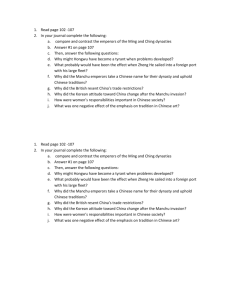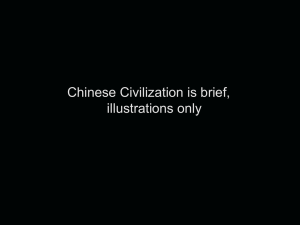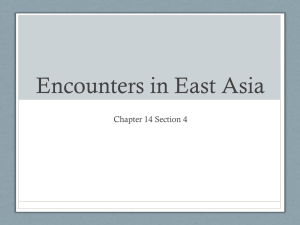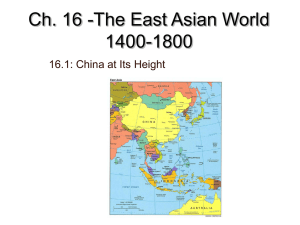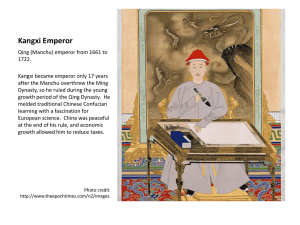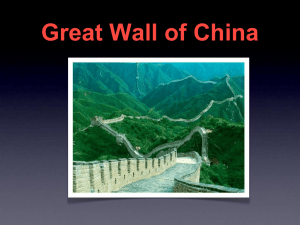2005: Arizona State University
advertisement
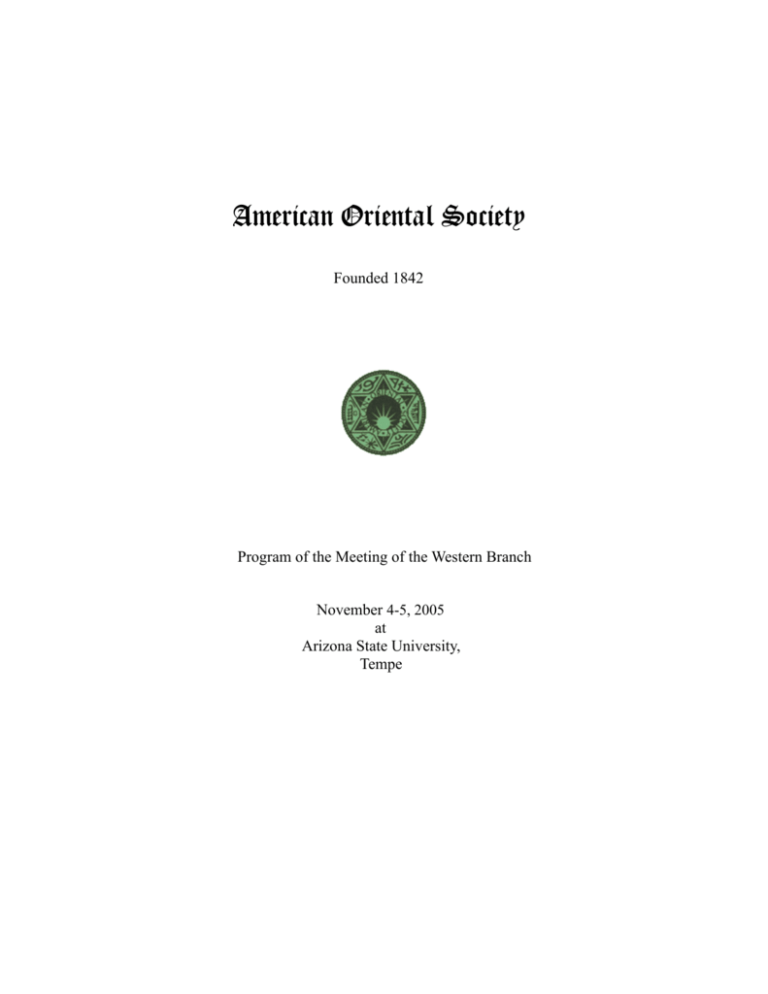
American Oriental Society Founded 1842 Program of the Meeting of the Western Branch November 4-5, 2005 at Arizona State University, Tempe Officers of the Western Branch American Oriental Society 2005-2006 President Ronald Egan Vice-President Jonathan O. Pease Secretary-Treasurer Stephen Wadley Executive Committee Michael Fuller Anna M. Shields Su Jui-lung Richard Von Glahn Timothy C. Wong Support for this meeting was provided by the College of Liberal Arts and Sciences and the Center for Asian Studies at Arizona State University PROGRAM NOTES 1. The meeting is held concurrently with an international conference on Chinese art in honor of the eminent art historian Chu-tsing Li,Professor Emeritus, University of Kansas. The two common activities on the program includes a buffet lunch, free to WBAOS participants, at the University Club on Friday, where there will be presentations by Martin Powers of the University of Michigan and Stephen H. West of Arizona State University. At 6:00 p.m. Friday evening, WBAOS participants are urged to attend a joint reception at the University Art Museum; artist and curator Xiaoze Xie of Bucknell University will be giving a gallery talk. 2. For the two panels with four presentations (III and VI), especially, the chairs are urged to keep strict watch over the allotted time. According to established practice, no paper should exceed twenty minutes, leaving ten minutes for discussion. 3. Continental breakfast (pastries, coffee, juices) will be available at the Alumni Lounge beginning at 8:15 a.m. on both Friday and Saturday. In addition, coffee and other liquids will be available throughout each day. 4. The traditional Presidential Address, “The Availability and Perceptions of Books in Song Dynasty China,” will be delivered by Professor Ronald Egan, the presiding president of the Western Branch, following the banquet on Saturday evening. All members of the University community are welcome to attend. American Oriental Society Western Branch Annual Meeting Alumni Lounge, Memorial Union Arizona State University, November 4-5, 2005 CONFERENCE PROGRAM Friday, November 4 Continental breakfast, 8:15 am—8:45 Opening remarks, 8:50—9:00 Panel I Pre-Tang and Tang Chair: Robert Joe Cutter 9am—10:30 Meow Hui Goh, The Ohio State University, “Patterning Sounds: An Illustrated Study of Yongming Poetic Prosody.” Kong Xurong, Columbia University, “Verisimilitude and Pragmatism: A Question in the Study of Fu Xuan’s yongwu fu. “ Young Kyun Oh, Arizona State University, “Ch’oe Chi-won and Hyech’o —Early Examples of Sino-Korean Cultural Exchange.” Panel II Tang Poetry Chair: Mark Halperin 10:45—12:15 Paul W. Kroll, University of Colorado, Boulder, “Xiao Yingshi’s fu on the An Lushan Rebellion.” David Schneider, Arizona State University, “Figurative Realism in Du Fu’s Poetry 752756.” Tyler Pike, University of Sydney, “Du Fu’s ‘Eight Phalanx Design’ and a Forgotten Inscription by Ruan Wen: Like ‘Putting Salt in Water’.” 12:30-1:45 Buffet lunch, University Club, with the Conference in Honor of Dr. Chu-tsing Li, Professor Emeritus, University of Kansas, “Perspectives on Chinese Art.” Presentations by Martin Powers, University of Michigan, “Song Gardens and Liberal Social Thought: Anachronism or History?” and Stephen H. West, Arizona State University, “Zhu Changwen (1041-1100) and the Garden of Joy.” 1 Panel III Medieval Writings Chair: Ding Xiang Warner 2:00—3:45 Timothy M. Davis, Columbia University, “Between the Canonical and the Common: The Religious Significance of Tomb Epitaph Inscriptions (Muzhiming 墓誌銘) in Early Medieval China.” Timothy Wai Keung Chan, University of Sydney, “Utterance at the Utterance: Ante Mortem Poetry in Early Medieval China.” Ping Wang, University of Washington, “The Art of Speech and Reticence.” Michelle Low, University of Colorado, Boulder, “In a Single Morning: Guo Pu’s Grieving Poems and His Southern Exodus.” Panel IV Essays Chair: Madeline Spring 4:00—5:45 Jiayin Zhang, University of Colorado, Boulder, “Mood, Experience and Ancestry: A Comparison of the Landscape Works of Liu Zongyuan and Liu Yuxi.” D. Morgan Davis, Brigham Young University, “Al-Ghazali on Interpretation and Metaphor.” J. Michael Farmer, Brigham Young University, “Subject of Shu/Prophet of Jin: A Reexamination of the Political Prophesies of Qiao Zhou.” 6:00-7:15 Joint Reception, ASU Art Museum, with the Conference in Honor of Dr. Chu-tsing Li. Gallery talk by artist and curator Xiaoze Xie of Bucknell University. Saturday, November 5 Continental breakfast, 8: 15am-8:45 Panel V The Song Dynasty Chair: Paul W. Kroll 8:45—10:30 Hoyt C. Tillman, Arizona State University, “Crossing the Frontiers Between the Southern Song and the Jin and Yuan: Exploring the Case of Hao Jing’s Comments on Learning of the Way Confucian.” Christian Soffel, University of Munich, “Overcoming Travel Compunction in Song-Ming Confucianism.” Kathleen Tomlonovic, Western Washington University, “Political Prominence of Empress Dowagers of the Song Dynasty.” 2 Panel VI Language and Linguistics Chair: Young Kyun Oh 10:45—12:30 Stephen A. Wadley, Portland State University, “An Outline of Manchu Language Study in the United States.” Richard VanNess Simmons, Rutgers University, “Dialect Vocabulary in Mandarin.” David Branner, University of Maryland, “Hakka Blues,” and a demonstration of poetryparsing software. Fang-yi Chao, University of Maryland, “The Emergence of the Verbal Classifier System in the Chinese Language.” Business Meeting 12:45—1:00 p.m. Panel VII Song-Ming Literature Chair: Richard Von Glahn 2:00—3:45 Jonathan O. Pease, Portland State University, “The Baochan Mountain Cave, Where Many Have Gone Before.” Daniel Bryant, University of Victoria, “Ming Poetry in the Twentieth Century: Bad Cheng Chen-to, Good Mao Zedong.” Yuming He, University of Chicago, “Laughing Matters—On Woodblock Print and Cultural Change in the Late Ming.” Panel VIII New Perspectives Chair: Jonathan O. Pease 4:00-5:45 Ching Hsien Wang, Academia Sinica, “Poetry on a Strange Isle.” Gary Flint, Independent Scholar, “Mountainsongs website.” Timothy C. Wong, Arizona State University, “Old Xiaoshuo in the Modern World: What Happened?” Banquet 7:00 pm, Ventana A, Memorial Union After Dinner Presidential Address, Professor Ronald Egan, University of California, Santa Barbara, “The Availability and Perceptions of Books in Song Dynasty China.” 3 ABSTRACTS Panel I. Friday, 9:00-10:30 a.m. “Patterning Sounds: An Illustrated Study of Yongming Poetic Prosody” Meow Hui GOH The Ohio State University The earliest surviving poems in Chinese history, such as those in the corpus of the Shi jing and the Chu ci, show that the Chinese, perhaps intuitively, had from very early been creating prosodic features that have generic significance. But it was many centuries later, during the short reign period Yongming 永明 (483-493), that we witness the first connected effort in Chinese history to argue for and experiment with the idea of sound patterning in literary composition. Preliminary studies have shown that through their pioneering endeavors the Yongming poets had produced many complex prosodic patterns quite unlike those commonly associated with Tang Recent Style Poetry and beyond the scope of the socalled “eight defects,” which earlier studies have single- mindedly focused on in their attempts to describe these inventions. Adding to the complexity of the issue at hand are suggestions made in some studies about the influence of Sanskrit poetry and the changing relationship between music and poetry in Chinese literary history on the Yongming prosodic movement. Limitations imposed by the loss of important texts notwithstanding, we are compelled to rethink the way to study Yongming prosody. Illustrated by a group of twentyfive Buddhist poems by Shen Yue and Wang Rong, this paper will propose an approach that emphasizes the concept of “discernible pattern” and aims for comprehensiveness. The term zhiyin (“one who understands music”), which readily calls to mind the story of Bo Ya and Zhong Ziqi, took on a different meaning during the Yongming era; when Wang Rong was attempting to write an essay on zhiyin, he undoubtedly had in mind “one who understands the sounds [of a literary composition].” By finding a viable approach to studying their prosody, we too contribute to the metamorphosis of the meaning of zhiyin. “Verisimilitude and Pragmatism: A Question in the Study of Fu Xuan’s yongwu fu” Xurong KONG Columbia University Liu Xie described literary works, particularly Ju, during the Six Dynasties as possessed of verisimilitude (xingsi). What does he mean by this? Why did rhaposodists compose fu in this manner? Based on Fu Xuan’s extant thirty-nine pieces, this paper attempts to answer these questions. By examining Fu Xuan’s choice of topics, his descriptive technique, and other relevant factors, I will attempt to discover the motive for his use of verisimilitude. The solution to the question may partly be found in the pragmatism of Confucian poetics. 4 “Ch’oe Chi-won and Hyech’o—Early Examples of Sino-Korean Cultural Exchange” Young Kyun OH Arizona State University This paper examines the differing circumstances of two Shilla students who went to Tang China, contrasting the lives of two Shilla intellectuals: Ch’oe Ch’i-won 崔致遠 (857?) and Hyech’o 慧超 (?-780). Ch’oe Ch’i-won, being from a noble family background, went to Chang’an and studied at the Guozijian 國子監. Hyech’o, on the other hand, went to Guangzhou as a monk, apprenticed himself to Vajrabodhi 金剛智 (ca. 702-741), and esoteric monk from India, traveled in India for three years, and came back to Chang’an to translate esoteric sutras into Chinese. Hyech’o spent most of his adult life in China, whereas Ch’oe came back to Shilla for a career in politics after serving in a position in Tang, upon having passed the civil service exam. The purpose of comparing these two contrasting lives is to demonstrate different facets of the cultural interaction between China and Korea in the beginning years. Ch’oe’s study in Chang’an was administered based on an international agreement between the Tang and Shilla governments. This inter-governmental exchange of scholarly talents, however, was in fact quite a feudalistic system, in which Shilla, as a feudalistic state, served Tang with their aristocratic elites. On the other hand, Hyech’o’s pilgrimage was a religious one, and his study was conducted outside any governmental institutions. Hyech’o, who became the second disciple of Vajrabodhi, was deeply involved with the development of Buddhism in China, as were many other Shilla Buddhist monks. I hope to illustrate divergent aspects of the beginning years of Sino- Korean literary interactions by examining the lives of these representative figures. Panel II. Friday, 10:45 a.m.-12:15 p.m. “Xiao Yingshi’s fu on the An Lushan Rebellion” Paul W. KROLL University of Colorado, Boulder Xiao Yingshi (708-759) is usually treated quite briefly in histories of Tang literature as one of several notable precursors of the so-called “guwen” movement. He was, however, a prolific and accomplished writer in many genres, including verse. He was an especially skilled composer of fu. All of his nine extant fu are interesting works, in various ways. Here we shall focus on his “Deng Yicheng guchengfu” (Fu on Ascending the Old Walls of Yicheng). Written in the late spring or early summer of 756, this long poem presents Xiao’s own response to An Lushan’s rebellion, which was then just a few months old. 5 “Figurative Realism in Du Fu’s Poetry 752-756” David SCHNEIDER Arizona State University In the autumn of 752 Du Fu (712-770) began to work out new ways to address political ideas in poetry, creating a unique political-philosophical poetics. Many have identified natural and descriptive realism—as distinct from literary tradition and convention—as a major feature of Du’s political and social criticism. Less well studied are the figurative aspects of the many seemingly realistic passages of Du ‘s poetry that, upon closer reading, often have as much to do with literary tradition as with descriptive realism. Call this figurative realism—a surface realism that points nonetheless to antecedent conventions and texts, a poetic method by which Du Fu builds into his descriptive texture multiple layers of meaning with multiple political and poetic resonances. “Du Fu’s ‘Eight Phalanx Design’ and a Forgotten Inscription by Huan Wen: Like ‘Putting Salt in Water”’ Tyler PIKE University of Sydney When read as a companion piece to an overlooked poem by the East Jin general Huan Wen, Du Fu’s famous quatrain yields new overtones. Although the allusive overtones in “Eight Phalanx Design” are elusive like “salt in water,” this paper attempts to situate the figure of allusion at the center of an interpretation strategy. My purpose is to explore what Du Fu is expressing about his own situation in life through these juxtaposed poems on a mysterious historical relic. Panel III. Friday, 2:00-3:45 p.m. “Between the Canonical and the Common: The Religious Significance of Tomb Epitaph Inscriptions (Muzhiming 墓誌銘) in Early Medieval China” Timothy M. DAVIS Columbia University Tomb epitaphs (muzhiming) are stone-inscribed documents with a pri marily religious function. Previous scholarship on early medieval muzhiming has emphasized their value as unaltered source material for studying the development of Chinese calligraphy or for supplementing traditional accounts of political and institutional history. Their religious significance has received almost no scholarly attention. Muzhiming originate at the convergence of two importan t inscription traditions: 1) canonical modes of commemoration represented by epitaph stele and 2) existing burial 6 practices of early medieval common religion (including the interment of “burial plot contracts,” “tomb quelling writs,” etc.). Both traditions have left their traces on the texts and physical features of grave memoirs. Close readings of a few recently excavated grave memoirs demonstrate that they were deployed in situations of exigent burial; such as cases where war, unrest, or great distance necessitated temporary burial away from the lineage homelands ( waizang 外葬), or when reburial was necessary because the tomb had been damaged or required relocation to more auspicious environs (gaizang 改葬). One also finds grave memoirs in situations where alterations have been made to a tomb, including occasions where joint or multiple burials have taken place (fuzang 附葬). I show that under these conditions, living kinsmen of the deceased felt obligated to place tomb epitaph inscriptions inside the grave—to secure the tomb, comfort the dead, and protect themselves from the inauspicious effects of their forebear’s demise. “Utterance at the Utterance: Ante Mortem Poetry in Early Medieval China” Timothy Wai Keung CHAN University of Sydney In early Chinese macabre poetry, the focus of poems written on anticipated, imagined death differs from that of poems written immediately before the poet’s unnatural death. Although the poetic classification linzhong 臨終 (“on the eve of my death”) was likely a retrospective editorial decision by a later hand, early relevant works by pre-Han and Han can be grouped into two categories: those expressing a feigned ante mortem sentiment, and those which constitute a reflecti ve utterance on untimely death. Thematic categorization is the most effective way to distinguish these two sub-genres of macabre poetry. Two themes are most prominent in poems written on the verge of an unnatural death—usually caused by execution. Specifically, they are: the expression of great fear for the end of one’s life, and regret for unfulfilled or mistaken political activities. These features clearly distinguish this sub-genre from poems composed on imaginary deaths, in which broadmindedness is expressed in a playful tone. My analysis of ante mortem poetry provides better ground for understanding Xie Lingyun’s 謝靈運 (385-433) “Linzhong shi,” the meaning and variants of which have long inspired scholarly controversy. “The Art of ‘Speech and Reticence”’ Ping WANG University of Washington Reclusion is a popular literary motif in earl y medieval China. The Yijing term “Speech and Reticence” has been used to refer to the two options presented to a scholar­ official: participation in or renouncement of the world. Reclusion, seemingly detrimental to any social aspiration, actually can be used to achieve “unintended” success. This paper examines an example of such through the close reading of an open letter written by Zhang Chong (ca. 483-510) in response to the emperor’s retraction of his father’s promotion. In this letter, “reticence” is 7 employed to make “speech,” and the rhetoric of “reclusion” becomes a forceful letter of selfpromotion. “In a Single Morning: Guo Po’s Grieving Poems and His Southern Exodus” Michelle LOW University of Colorado, Boulder The beginning of the fourth century in China was plagued by internecine struggle, ethnic rebellion and war. This internal strife weakened the stability of the Jin dynasty, and the government was forced to flee south to Jianye (modern Nanjing) to eventually establish a new capital in exile. During this time, thousands of Jin loyalists left their homes in the traditional heartland of China for safety and stability south of the Yangtze, where the natural landscape provided sanctuary from the trouble in the north. The mass migration southwards to the Jiangnan 江南 meant that for the first time ever, the people of the Central State had to abandon their traditional homeland and heart of civilization along the Yellow River valley for unfamiliar and somewhat exotic territory in southern China. Aside from being the place where their childhood memories and families were rooted, the Yellow River valley also represented the sacred space of the traditional Chinese heartland. The capitals at Chang’an and Luoyang along the Yellow River were the political and cultural centers of several dynasties, and the sites where hundreds of years of shared history transpired. The Yellow River valley symbolized the cradle of Chinese civilization, and provided the point of reference the loyalists needed to define themselves. They identified with this long tradition of the Yellow River valley and tacitly believed it to be the superior culture. When the state was forced to move its political center and sphere of influence and control to a new location, their sense of identity and personal security was disrupted. This paper examines one poem by Guo Pu, “Grieving Poems in Reply to Jia Jiuzhou” 答賈九州愁詩, to shed some light on the refugee experience in the early fourth century in China, and how one man in particular dealt with the refugee experience. Panel IV. Friday, 4:00-5:45 p.m. “Mood, Experience and Ancestry: A Comparison of the Landscape Works of Liu Zongyuan and Liu Yuxi” Jiayin ZHANG University of Colorado, Boulder As the leaders of the guwen movement 古文運動, Liu Zongyuan 柳宗元 (773819) and Liu Yuxi 劉禹錫 (772-842) had a strong influence on the genre of landscape description and narration. Depressed by being banished from powerful positions to remote places, they visited many locations as a means of passing the time and composed many landscape works to record their travels. This effort facilitated the maturation of the landscape prose genre. However, though they were close friends with strikingly similar 8 experiences, their styles of writing differ greatly. This study investigates the different characteristics of their essays which were composed in the same state of their lives, and furthermore, explores the personal, familial, and other factors that bring these dissimilarities to their landscape works. “Al-Ghazali on Interpretation and Metaphor” D. Morgan DAVIS Brigham Young University In one of the lengthiest sections of his major theological treatise, al-Iqtisad fi al-I’ tiqad, al-Ghazali (d. 1111) develops a discussion of how to properly interpret the apparently anthropomorphic language of the Qur’an. He begins with the case of God’s sitting upon a throne, but in the course of his discussion offers metaphorical interpretations of a number of other problematic Qur’anic verses and prophetic sayings, discussing in some detail the principles that ought to govern in deriving the correct interpretation. This paper will examine the tradition of interpretation out of which al- Ghazali’ s approach grew and will consider as well this approach as evidenced in such later works as Mishkat al-anwar, and Iljam al-awam ’an ‘ilm al-kalam. “Subject of Shu/Prophet of Jin: A Reexamination of the Political Prophesies of Qiao Zhou” J. Michael Farmer Brigham Young University Qiao Zhou, often represented as a “traitor” to the efforts of Liu Bei and Liu Shan to “restore the Han dynasty,” left behind a small but significant body of political prophesies, some of which supported the Liu’s dynastic ambitions, others which proclaimed the Liu’s venture to be doomed, and a final set of prophesies which have confused would-be interpreters for centuries. This brief paper will examine these three sets of prophesies in an effort to establish a different view of Qiao Zhou than “traitor.” Qiao’s prophesies regarding the state of Shu-Han are fairly easy to decode, and will be briefly summarized. However, the set of cryptic prophesies dealing with the loss of territory on the Chengdu Plain requires a significant shift of assumptions in order to be understood. Here, I will offer a possible interpretation of these mysterious remarks. In the end, I hope to show Qiao Zhou as a man guided by faith in the will of Heaven as interpreted through celestial signs and prophetic word-play, and not bound by baser ties of loyalty to a particular political regime. 9 Panel V. Saturday, 8:45-10:30 a.m. “Crossing the Frontiers Between the Southern Song and the Jin and Yuan: Exploring the Case of Hao Jing’s Comments on Learning of the Way Confucian” Hoyt C. TILLMAN Arizona State University My recent research on the late Jin and early Yuan Confucian statesman and scholar Hao Jing 郝經 provides additional perspective on some of the ways that rival narratives about the Confucian tradition were eclipsed by the Zhu Xi school’s version of the Daoxue tradition. Mainstream scholarship, such as the official Yuan History 元史, has proclaimed that the Han Chinese in North China, under the sway of first the Jurchen Ji n and then the Mongols, were unfamiliar with the philosophy of Cheng Hao 程顥, Cheng Yi 程頤 and Zhu Xi until 1235 when a Mongol raiding party captured Zhao Fu 趙復 in the South; soon thereafter, the Mongol regime established the Great Regime Academy 太極書院 in Yanjing (Beijing) where Zhao introduced Southern Song Daoxue to students in the North. In the 1980s, I collected evidence of Daoxue ideas and publications in North China under the Jin and thus published a challenge to this conventional view. My current research explores Hao Jing’s evidence and basis for a narrative of a Confucian intellectual lineage from Cheng Hao in North China that began in the Northern Song and persisted through the Jin and into the Yuan. As a young man, Hao Jing’s classical scholarship and selfcultivation attracted positive attention of Daoxue leaders Wang Cui 王粹 and then Zhao Fu himself. Initially, Hao Jing declined Wang Cui’s invitation to join the Daoxue fellowship because Hao Jing was concerned about the controversies in the Southern Song about the label Daoxue, and worried that the label would also provoke the same kind of intellectual divisiveness and political contention in the North that it had already done in the South. Moreover, he claimed that the transmission of the Chengs in North China had not used that label. He emphasized that Cheng Hao had established a Confucian legacy while serving as a local official in Jincheng 晉城 in Shanxi, and the legacy of Confucian learning had been continued and passed down through his own family. But before long, Hao Jing was using the Daoxue label; moreover, he praised Zhao Bingwen 趙秉文 and other leading Jin intellectuals for identifying with and developing the Daoxue tradition. In addition to changing his mind about the acceptability of using the term Daoxue, Hao Jing treated Zhao Fu as a teacher when Zhao Fu later visited him in Baoding 保定. Even though Hao Jing continued his insistence on remembering the legacy of the Cheng brothers in North China through the Jin era, his own deference to Zhao Fu and praise of the Great Ultimate Academy apparently contributed to the ascendancy of that line of transmission from Zhu Xi’s disciples in the South. Hao Jing thus inadvertently contributed to the failure of the northern legacy of the Chengs to secure a place in the grand historical narratives of the evolution of Daoxue that were established by Yuan and Ming Confucians. According to Hao Jing and other historical evidence, Daoxue fellowship and ideas were influential in the North before the arrival of Zhao Fu and his Good News about Zhu Xi’s teachings; nevertheless, that historical reality distracted from the Zhu Xi centered version of Daoxue that Zhu Xi’s more direct disciples and later followers were busily propagating and creating. Thus this case exemplifies the tendency from the Southern Song through the Ming and beyond to reconfigure Confucian tradition(s) and expunge diversity. 10 “Overcoming Travel Compunction in Song-Ming Confucianism” Christian SOFFEL University of Munich Being a popular topic in various kinds of Chinese belles-lettres, the notion of “travel” is only very restrictively used in the realm of Confucian philosophy. While in Taoist texts like Zhuangzi and Liezi spiritual travel plays a significant role, the mobility of the Confucians is entirely restricted by the priority given to filial piety. A journey to a different place prevents the child to enact the care it owes to its parents. We can find relevant passages in the Lunyu and in the Li ji. When these books are used for educational purposes, an anxiety towards traveling is implanted into the personality of young children, which has still aftereffects on the psychology of the adult, even long after the parents have deceased and the obligation of filial piety actually no longer exists. On the other hand, the Confucian scholar faces quite often the necessity of traveling far away, either to fulfill orders given by his superiors, or to pursue academic advancement. In such a case there can easily evolve an inner conflict, which more often than not is expressed in literary works. Philosophical discourses on “traveling” are, however, relatively rare. In this paper I want to discuss the philosophical ideas on the topic of “travel” in Song and Ming Confucianism. The analysis will mainly be based on comments on those few passages of the Confucian canon where “travel” is mentioned. We will observe that Song Confucians like Zhu Xi show a rather conservative attitude. On the contrary, the Donglin Confucians from late Ming dynasty address this issue in a rather relaxed way. This cannot just be explained by the basic ideological opinions of these people, but rather requires further consideration of their social background and the reactions caused by it. “Regent Empresses of the Song: Women of Prominence and Patronage” Kathleen TOMLONOVIC Western Washington University The Song shi 宋史 “Biographies of Empresses and Consorts 后妃傳 includes a summary of the achievements of several prominent women of the Song court. Compilers conclude that the Song was fortunate during its three hundred years of rule because it avoided the ordeal of interference from the family of the empress, as in the Han, as well as the misfortune of an empress seizing the throne, as in the Tang. However, the records reveal that political situations during the Song brought to prominence several competent women who influenced not only the sons for whom they served as regents, but also the scholarofficials who sought their favor and support. Empress Liu 劉皇后 (969-1033) who, subsequent to the death of her husband Zhenzong 真宗 ignored the ministerial requests that she leave the court, assumed the role of empress dowager for Renzong 仁宗 (1010-1063), and conducted court affairs from behind the screen. Toward the end of Renzong’s reign, his wife, Empress Cao 曹皇后 (d. 1069), played an important role as officials, such as Sima Guang 司馬光 (1019-1086) pressed for the adoption of an heir. As political factionalism intensified during the late eleventh century, Dowager Empress Gao 太皇太后 (1032-1093) and Dowager Empress Xiang 向太皇太后 11 made decisions that supported or hindered particular groups. Scholar-officials, later designated Yuan you partisans, enjoyed the favor of Regent Empress Gao during the early reign of her grandson Zhezong 哲宗 (1077-1 100). Her death in 1093 prompted a political shift and the subsequent exile of many prominent officials. Although the reign of Empress Xiang brought a brief interlude of patronage for the Yuanyou era officials, conditions at the court favored the supporters of Emperor Huizong 徽宗 (1082-1135), who rejected her positions and her preferred ministers. Both Empress Gao and Empress Xiang were involved in the selection of Empress Meng 孟太后 (1077-1135), who became the principal regent during the time of turmoil following the Jurchen invasions of China. While former Emperor Huizong and his son Qinzong 欽宗 (1100-1161) lived in captivity among the Jurchen, Empress Meng assisted with the reestablishment of the dynasty in the South, first serving to legitimize the rule of Gaozong 高宗 ( l 107-1 187) and later to guide the Southern court. The women exhibited remarkable resiliency and adaptability in the context of court politics. A consideration of their activities and influence enhances our understanding of the complex political and social features of the Song Dynasty. Panel VI. Saturday, 10:45 a.m.-12:30 p.m. “An Outline of Manchu Language Study in the United States” Stephen A. WADLEY Portland State University Compared to other Western countries, the teaching of Manchu Language came late to the United States. And rather than being a part of a Chinese Studies program as in Europe, it appears nearly all Manchu class offerings were appendages to Mongolian language studies programs. Ferdinand Lessing brought Altaic language classes, perhaps including Manchu, to Berkeley in the first half of the twentieth century. Francis Cleaves, as part of the rapid proliferation of “Area Studies” on US campuses following World War II, established Mongolian classes at Harvard by mid-century. Cleaves also knew Manchu and must at least have taught some Manchu to Joseph Fletcher who succeeded him at Harvard and did offer Manchu language courses on at least two occasions. James Bosson began to teach regularly scheduled Mongolian and Manchu classes at UC Berkeley in the sixties. This marks the first time regular Manchu classes entered the catalog at an American university. At about this same time at Indiana University, Denis Sinor was establishing Mongolian language classes. Although Professor Sinor is a Manchu scholar of note and had taught Manchu at least once in Europe, he never taught it at Indiana. Professors who came afterward, however, did begin to offer Manchu classes there on an ad hoc basis. Later, in the seventies, when Jerry Norman arrived at the University of Washington, he began to teach Manchu classes. These were at first taught as overload courses but later Manchu was added to that university’s regular curriculum. Of these four fledgling Manchu language programs in the United States, two have disappeared entirely with the retirements of the professors who began them. Manchu is no longer taught at Berkeley or at the University of Washington. Manchu is still taught 12 occasionally at Indiana but is not part of the regular curriculum. In the United States now, only Harvard offers regular Manchu language classes. Manchu, however, is still being taught in the U.S. at universities here and there as an overload class. Several outstanding Qing dynasty historians have recently demonstrated the value of looking at Manchu language sources to reconstruct the history of the Qing; yet Manchu language offerings in the United States appear to be faltering. It remains to be seen if this trend will continue. “Dialect Vocabulary in Mandarin” Richard VanNess SIMMONS Rutgers University The project to investigate the boundary between Wu and Jiang-Huai Mandarin Dialects was intended to focus on the differences between the two dialects and to determine the geographic range of those differences in southern Jiangsu. In the past, the dialects of this region have often been noted more for their similarities and how they blurred the distinction between Mandarin and Wu. Nantong and Rugao dialects, for instance, have been considered to contain a Wu substratum. Our investigation has clearly determined that a distinct line of bundled isoglosses is found between the two dialect types here; but man y similarities also remain quite apparent. This paper examines characteristic regional vocabulary that is shared by both Mandarin and Wu dialects in Jiangsu across isogloss boundaries delineated by other words and features. “Hakka Blues” David Prager Branner University of Maryland at College Park Among the celebrated genres of Chinese folk poetry is the shan‘ge 山歌, an improvised form associated with Hakka women doing field labor in the mountains, especially picking tea. “Tsaecharge” 采茶歌 are attested from the time of Luh You 陸游 (1125-1210). The form seems to have died out as a living practice in China not long after the 1949 revolution, although it persists as a kind of museum piece, as does the chanting of refined literature. In spite of the general tendency of literary people to rewrite folk literature, Ferng Menqlong 馮夢龍(1572-1646) and E.J. Eitel (1838-1908) are among those who documented shan’ge apparently unretouched, beyond the needs of transcription into Chinese characters. The paper presents recordings and analysis of twelve songs improvised in March, 2005, by Mrs. Jong Shihmey 鍾細妹, a 90-year old villager from the mountains between Charngting 長汀 and Shanqharng 上杭 counties (belonging to the former Tingjou Prefecture 汀州府) in China’s Western Fwujiann Province. Jong Shihmey’s command performance for a foreign visitor produced a surprising response from her family, recalling the vexata quaestio of the place of traditional culture in modern society. 13 “The Emergence of the Verbal Classifier System in the Chinese Language” Fany-yi CHAO University of Maryland at College Park This paper investigates the emergence of the Chinese verbal classifier system and its significance to the forming of the conceptual classification structure of Chinese. Having examined the relation between the early verbal classifiers and the nominal classifiers which originated from verb forms, this paper postulates three factors to account for the emergence of Chinese verbal classifiers: ( 1) the use of verbs as nominal classifiers contributes to the syntactic ambiguities in “V + numeral + Vc”; (2) the post- verbal temporal expressions validates the PP feature of the “numeral + Vc” phrase; and (3) the need of the semantic as well as syntactic disambiguation triggers the reanalysis of the “V + numeral + Vc” structure. Based on Taylor (2002) this paper demonstrates that the appearance of the verbal classifiers is a direct consequence of the refinement of the conceptual structure of verbal phrase in Chinese. Panel V. Saturday, 2:00-3:45 p.m. “The Baochan Mountain Cave, Where Many Have Gone Before” Jonathan O. PEASE Portland State University Wang Anshi’s essay about a spelunking expedition he took with four other young men in the fall of 1054 is not ensconced in the canon as a stern plea, directed in particular at youthful anthology readers, to seek less-traveled roads on their journey toward wisdom. Modern critics have excavated paradoxes, metaphors and sophisticated nuances from beneath its plain speech. But apparently no one has thought to ask a glaringly obvious question about the expedition itself, whose answer might reveal an inside joke that has been lost to those of us who were not at the cave that day. “Ming Poetry in the Twentieth Century: Bad Cheng Chen-to; Good Mao Tse-tung” Daniel BRYANT University of Victoria The poetry of the Ming dynasty enjoyed little popularity during the twentieth century. In large part this was due to the dismissive attitude toward most of it adopted by Chinese scholars of the May Fourth generation. This paper reviews the treatment of Ming verse by these writers, concentrating on the history of Chinese literature published by Cheng Chen-to. In more recent times, the picture has begun to change, with many signs that a revaluation of Ming and other post-Sung poetry is under way. Among the earliest people to express at least a grudging approval of Ming poetry was none other than the most 14 influential amateur critic of the age, Mao Tse-tung. This paper suggests that he may even have been indirectly responsible for the publication of a classic anthology of Ming verse in the waning days of the Cultural Revolution. “Laughing Matters—On Woodblock Print and Cultural Change in the Late Ming” Yuming HE University of Chicago In the late Ming, a burgeoning market in woodblock publications, and the concomitant appearance of a wide range of new publishing genres, left an indelible mark on Chinese society. Laughter was one commodity that was marketed and produced with particular effectiveness in woodblock publications of this period. This paper examines the specific sorts of “laughing matters” that appear in the late-Ming daily-use encyclopedias and related publication genres, and attempts in this way to shed light on the particular cultural space created in this stratum of print culture. Compendia of jokes, brothel literature, language games, songs, and illustrations, are all in fact deeply embedded in a rising form of cultural memory that emerged in conjunction with the social and economic phenomenon of the woodblock publication industry. Under careful examination, such “laughing matters” allow us not only to understand ways in which people of this period amused themselves, but also reveal a historically unique set of attitudes about interpretation and the textual past that was shared by the original audiences of these publications. Panel VIII. Saturday, 4:00-5:45 p.m. “Poetry on a Strange Isle” C.H. WANG Academia Sinica Beginning in the mid-seventeenth century there were Chinese poems written of Taiwan, about its landscape, customs, and other possible subjects. Their authors included variably a political outcast and some scholar-officials appointed by the Manchu court to the island on circulatory basis or, perhaps, on banishment. The former, specifically, was the man named Shen Kuang- wen (1612-1688), a Ming loyalist blown lost in a typhoon during a sea journey and miraculously washed ashore on south Taiwan—hailed today as the patriarch of Taiwanese poetry. Those among the scholar-officials were Sun Yuan-heng, who was sent to the forlorn territory on a civil appointment in 1703, and Chang Mei, a generation later in 1741. It is the product of the latter individuals and their like that abounds in peculiar penchant for what they observe as curios, the strange, the uncultured, the abominable. What nature yields in fauna and flora, for example, somehow do not always conform to the definitions given in the classical manual, and the difficulty turns out to be a challenge and mock at their imagination. 15 “Mountainsongs Website” Gary FLINT Independent Scholar I will present an online slideshow of my website www.mountainsongs.net. MountainSongs is a bilingual database website which connects Chinese poems and poets to the places where the poems were written by means of digital images and GPS data. The next stage of development will include historical time maps. “Old Xiaoshuo in the Modern World: What Happened?” Timothy C. WONG Arizona State University Since the first decade of the twentieth century, Chinese fictional narratives, or xiaoshuo, have gradually been “globalized,” i.e., considered from perspectives foreign to the cultural premises under which they were written and read. In China and elsewhere, the change in the perception of such writings took on great momentum after Liang Qichao (1873-1929) advocated using them as a medium for political reform, and Hu Shi (18911962) seized upon their vernacular prose as a model for all writings. My presentation will examine the effect of these pragmatic burdens, which brought about the nearly universal assumption that Chinese fictional narratives from the Ming and Qing dynasties are essentially like their counterparts written in Europe and America since the nineteenth century. I will also raise the question of whether the assumption ultimately aids or impedes our understanding of how and why the Chinese used to fictionalize. 16
